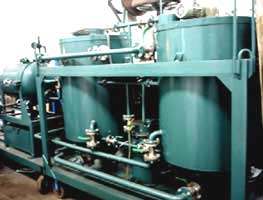 |
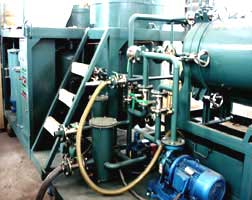 |
These plants are suitable to regenerate both engine oils, including diesel engine oil and gasoline engine oil and other machinery oils such as hydraulic oil, lubricating oils etc
LGUER series machines can effectively remove colloid, oxid, acid, pitch, particles, impurities water gas in the oil.It can also restore color and transparancy in the oil.

Main specifications:
-
Two main filtering systems which can ensure LGUER works continuously by batch.
-
Environment friendly.
-
Design according to different customers’ needs including Turnkey project ;
-
Purify blended oils.
-
Law ,maintenance and operation costs
-
High regeneration rate
-
Automatic reverse wash system will extend the lifetime of filters and improve the performance of the filters.
|
Item
|
Unit
|
LGUER-1
|
LGUER-2
|
LGUER-3
|
LGUER-4
|
LGUER-5
|
LGUER-6
|
|
Treatment capacity
|
kg/8-10hrs | 2000kg | 4000kg | 6000kg | 8000kg | 10000kg | 14000kg |
| Regeneration rate | % | 75-95% | |||||
| Working pressure | MPa | -0.095-0.4 | |||||
| Temperature | С | 60-200С | |||||
| Working noise | Db(A) | No more than 90Db | |||||
| Heating power | KW | 86 KW 96 KW 180 KW | |||||
| Inlet/outlet pipe diemeter | mm | 40 | |||||
| Weight | kg | 2500 | 30500 | 4500 | 6500 | 8500 | 12850 |
Dimensions LGUER-5
| Item | Size (l*w*h) mm |
Weight kg |
Dimensions with packing mm |
Weight of packing kg |
| Reactor I | 3050*2180*2225 | 1500 | 3200*2290*2450 | 300 |
| Reactor II | 2620*2180*2225 | 1500 | 2750*2290*2450 | 300 |
| Filtering device I | 3265*1610*1650 | 2000 | 3400*1750*2200 | 300 |
| Filtering device II | 3265*1610*1650 | 2000 | 3400*1750*2200 | 300 |
| Exhaust gas processor | 900*1900*3300 | 1000 | 1150*2050*1400 | 150 |
LGUER-1
 |
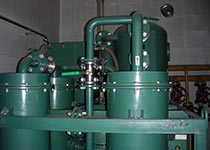 |
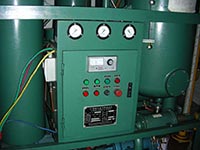 |
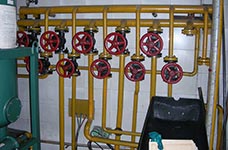 |
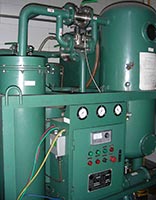 |
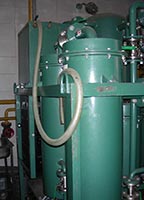 |
Storage vats 2,50*1,3*2 m, 2 pcs are required.
Dimensions 3*1,7*2,10 m
Weight 2500 kg
Power 118 kW, heating power 86 kW
Chemical reagents
During operations it is necessary to add three substances :
1. Al2O3.4SiO2.nH2O (solube glass ) price 350-370 $/ton (price in 2017)
2. Na2O.nSiO2.mH2O (activated clay ) price 240-260 $/ton (price in 2017)
3. С8Р23N5 Tetraethylene (Tetraethylene Pentamine) price 8800-9200 $/ton (price in 2017)
The reagent is low toxic, it should be kept safe from sun rays.
4.С8HNCL polyydemethylammonia
Volume of additive (percentage of oil volume)
1. Al2O3.4SiO2.nH2O 10-25%
2. Na2O.nSiO2.mH2O 1-3%
3. С8Р23N5 Tetraethylene (Tetraethylene Pentamine) 0.5-1% (the main one)
4.С8HNCL polydemethylammonia 0,1-0,25 %
Operation
Used oil is filled into receiving hopper. It is heated under conditions of permanent stirring, passes rough filtration via steel filter, all large inclusions such as stones, sand, metal are removed followed by addition of aluminosilicates provided heating according to technological rules and observing oil treatment time behavior. Reagent adding ratio may vary depending on contamination and reduction of acid number. Oil is pumped to reagent vat, the resultant sand is removed and other reagents are added. Then according to the schedule preset time filtration via oil fine filter begins, then the purifiedied oil goes to collecting tank to cool followed by pouring into 200 L metal barrels. The barrel are sent to the finished products warehouse Then steel filters should be taken off to clean.
1. Operatioon area:
Operation area shoud be closed and ventilaatted properly .
Required space - more than 60 m2 (L 12 m, W 5 m)
2. Cable:
Cable should be connected to the working space .
Cable specifications: (3×120mm 2+1×70mm 2). The best way for cable is (3×150mm 2+1×70mm 2).
Power supply should operate in standard mode
3. Barrels:
More then 5 standard barrels or 1 oil tank, 2 voulumetric vessels ( volume more than 10 liters) 2 drums, 15 Liters
4. Mounting tools :
Spanners, wrenches, screwdrivers, scissors, rulers etc
5. Laboratory
Lab with power supply 220V 50Hz and water supply. Chemicals for experiments
6.Chemicals for treatment of the discharged gas :
Vinegar 98%(C2H4O2, CH3COOH) 50kg or sodium hydroxide (NaOH)50 kg
7.Forklift
8. Coarse filter and fine filter :
Coarse filter is made of steel with conical hole (inlet - 1000 mesh,outlet - 500 mesh). Stainless steel is recommended. Fine filters can be made of steel or fabric, Each type has its advantages and disadvantages. Metal filter, made of steel sheets is cheap, and has a long service life, but a lot of sludge remains in oil, and it is difficult to clean it .
Filter made of silk bolting cloth is plate and frame filter. Boilting cloth 600-150 mesh is used. Price of material - 150-200 RMB/meter. It is easily mountable and dismountable. easily cleaned of sludge, no oil remains. Diisadvantages: Short service life, high vulnerability, so it necessary to operate it very carefullym and realsilk boltingl cloth can not be replaced by synthetics.
*Specific operation manual for running each typpe oof equipment is given to Customer after purchasing. General operation principles are similar
The report of treatment of used СС40
|
Item
|
Unit
|
Theory index
|
Treated oil index
|
|
Flow viscosity
|
100 М mm2/S
|
12.5-16.3
|
11.6
|
|
Flash point
|
> =
|
220
|
232
|
|
Acid mgkoh/g
|
< =
|
2.0
|
0,04
|
|
Impurity %
|
< = | 0.01 | 0.06 |
| Water-solubility acid or alkali | / | / | No |
| Viscosity index | > = | 80 | 91 |
| Pour point | < = | -10 | -26 |
| Silfate air | / | / | 0.172 |
Questions & Answers:
1) How can LGUER can run continuously?
LGUER regenerates waste oil by batch. NSH designed two main filtering systems in the LGUER which can ensure that GER work continuously by turns.
2) Can LGUET|R regenerate mixed oils?
Yes, LGUER can regenerate mixed oil including diesel engine oil, gasoline engine oil, hydraulic oil, gear oil and other industrial lubrication oil.
3)What residues or by-products can LGUER produce after regeneration?
For standard LGUER series, there are some residues or by-products. There is graphite exist in residues. The graphite is a very valuable substance, customer can extract graphite from residues by themselves. For advanced LGUER series, there are little residues or by-products coming into being during production. (Advanced LGUER series has device which can dispose residues or by-products.)
4) How to dispose residues and by-products?
For Standard LGUER series, customer can burn them or bury them. Additionally, customer can sell then to other factories as fuel.
5) Is every time’s treated oil’s performances the same?
It depends on waste oil. If each batch of waste oil’s performance is the same, the treated oil’s performance is the same
6) What is regeneration rate?
It depends on compositions of waste oil which you want to treat. If there is lots of water, impurities or other matters in waste oil, the regeneration rate is low.
7) What is treated oil?
The treated oil is base engine oil, the grade of treated oil is a bit lower than virgin oil’s.
8)What are treated oil’s applications?
The treated oil can be used as machinery’s lubrication oil, diesel engine oil or other lubrication oil. Customers can add additives to treated oil according to definite applications before reuse. Treated oil can also be used as fuel.
9)What are differences between virgin oil and treated oil?
If the waste oil’s properties (before use) are high, the treated oil’s properties are also high. Generally, the regeneration process doesn’t affect main performances of oil. Some indexes are lower than new oil’s, some indexes are the same as new ones’. (Please refer to test report)
10) Are there any chemical materials needed during processing?
Yes, there are some chemical materials needed in the process (please contact our sales, they will provide you detailed information.)
11) How long is lifetime of LGUER plant?
The life time is more than 8 years under proper operation.
12) What about the maintenance of LGUER?
The maintenance is very simple. Replace lubrication oil for vacuum pump every year. Check the filters, valves, gaskets periodically.
13) Does LGUER needs professional engineers to operate?
The operation of LGUER is very simple. Generally, two or three workers can operate it after two days’ training.
14) Does LGUER needs auxiliary equipments?
.We suggest that customer order an air compressor which is to improve efficiency of cleaning filter (customers can get it in your own market.). We also suggest that customers order LV oil purifier plant series from NSH. Because customers can use LV to remove particles, water and so on. Generally, customers store treated oil in big tank. During a storage period, there are moisture or impurities dissolved into treated oil.
15) How to install LGUER?
Customer can install LGUER according to operation manual. For LGUER product line, NSH will send engineers to customers’ work site to supervise installation. NSH also provide turnkey project for customers. NSH will establish a workshop for customers including auxiliary facilities.
16) What space does LGUER need?
For GER-1, 2, 3, 4,5, it needs about 200 square meters for operation. For GER product line, NSH engineers will design it for customers as neede.
17) How long is the delivery time?
For standard LGUER models, it needs about 50 working days’ production period in NSH factory. For LGUER product line, it needs one or two months’ design time, four months’ establishment time (including manufacture time in NSH factory then transport to customer’s work site and installation period of LGUER and auxiliary facilities ).
18)What kinds of engine oil LGUER can not regenerate?
Generally, LGUER can regenerate most engine oils. But gasoline engine oil, GER can remove colloid, oxid, acid, water, gas. But the color of treated oil is wine’s color should mix it with used hydraulic oil or low grade treatment in order to get good treatment oil’s color.
19) How long is warranty period?
The manufacturing plant Warrants the plant supplied under this specification against defects in material and workmanship under normal use and service for a period of sixteen (16) months from date of shipment or twelve(12) months after the start up of the system. SINO-NSH’s obligation under this warranty is limited to repairing or furnishing, without charge F.O.B. point of manufacture, a similar part to replace any part, which was proven to be defective within warranty period. SINO-NSH shall not in any event be held responsible for any indirect or consequential damages. The performance guarantee will be within limitations as detailed in duty & performance paragraph of this specification..
LGUER-4 oil regneration plant

Legends
|
А) Main filter
В) Waste oil pump
С) Filtration pump
D) Vacuum regulator
E) Sewage pump
I) Regeneration device I
F II) Regeneration device II
G I) Filtering device I
G II) Filtering device II
H) Circulating pump
J I) Mixer I
J II) Mixer two II
K) Water cooling pump
L) Exhaust gas pump
M) EXhaust gas decompression device
N) Water tank
O) Water cooler
P) Exhaust gas filter
Q) Tank
R) Circulating oil tank
S) Radiator
T) Heater
V) Fine filter
W) Vacuum separator
|
1. Waste oil inlet valve
2, 13. Separating valve
3, 11. Regeneration device I,oil outlet valve
4, 12.Regeneration device II,oil outlet valve
5.Regeneration device I circulating oil inlet valve
6. Regeneration device II circulating oil inlet valve
7. Regeneration device I oil inlet valve
8. Regeneration device II oil inlet valveУ
9. Filtering device I, inlet air valve
10.Filtering device II, inlet air valve II.
14. Supplementary valve
15,17. Filtering device I, oil inlet valve
16,18. Filtering device II, oil inlet valve
19. Filtering device I,circulating valve
20. Filtering device II,circulating valve
21. Filtering device I, overflow valve
22. Filtering device I, overflow valve
23. Filtering device I, pure oil outlet valve
24. Filtering device II, pure oil outlet valve
25, 26.Vacuum separator, inlet valve
27. Waste oil inlet valve
28. Vacuum valve
29. Oil circulation pump for inlet valve
30. Oil circulation pump for outlet valve
31. Vent valve
32. Discharge gas outlet valve
33. Discharge gas outlet valve
34. Water cooling valve
35. Water tank outlet valve
36. Filter outlet valve
37. Discharge gas outlet valve
38. Separate oil inlet valve
39. Outlet valve for circulating oil tank
40. Valve for the heater
41. Circulating oil inlet valve
42. Regeneration device II, air pump valve
43. Regeneration device I, air pump valve У
44. Check valve
45. Vacuum measuring device
46. Filtering device II, pneumatic measuring device
47. Filtering device I, Pneumatic measuring device
48, 49.Safety valve
50, 51, 52. Bleeder valve
53. Main filter outlet valve
54. Vent valve pump
|
LGUER-4

Oil regeneration unit LGUER-5
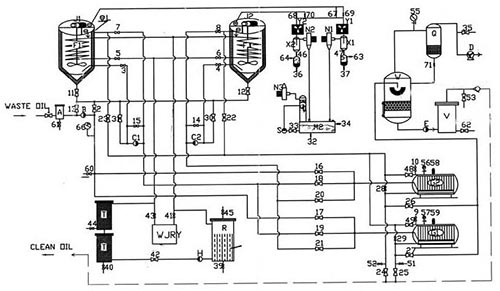
Legends
|
А) Preliminary filter
В) Waste oil pump
С1, С2) Filtering pump
D) Vacuum pump
E) Pure oil pump
FI) Reactor I
FII) Reactor II
G I) Filtration unit I
G II) filtration unit II
H) Circulating oil pump
J I) Mixer I
J II) Mixer II
L) Loading device
M1, М2) Exhaust gas treatment device
N1,N2,N3)Evaporating device
PI, PII) Water containers
Q) Foam dissipation device
R) Circulating oil tank
S) Water pump
T) Heater
V)Fine filter
W) Vacuum separator
XI, XII) Cooler
YI, YII) Radiator
WJRY) Outer heater
|
1. Waste oil inlet valve
2. Isolating valve 3, 11. Oil discharge valve of reactor I
4, 12. Oil discharge valve of reactor II 5. Oil circulating valve of reactor I
6. Oil circulating valve of reactor II
7. Inlet oil valve for reactor I
8. Inlet oil valve for reactor II
9. Inlet oil air valve for reactor II
10. Inlet air valve of filtering unit II
13,46,47 Isolating valve
14,15. Pressure control valve
16,18,20. Inlet oil valve of filtering device II
17,19,21. Inlet oil valve for filtering device I
22,48. Water discharge valve of filtering device II
23,49. Water discharge valve of filtering device I
24. Pure oil outlet valve of filtering deviceII
25.Pure oil outlet valve of filtering device I
26,27. Oil inlet valve of vacuum separator
28. Overflow oil valve of filtration device II
29.Overflow oil valve of filtration device I
30. Oil inlet valve of filtering pump С2
31. Oil inlet valve of filtering pump С1
32. Branch valve of exhaustt gas treatment device
33. Pump inlet valveВпускной клапан водяного насоса
34. Overflow valve
35. Vacuum valve
36,37. Branch valve
39. Oil circulation tank branch valver
40,44. Heater branch valve j,
41. Outer heater inlet valve
42. Oil circulation pump oil discharge valve
43. Outer heater outlet valve
45. Vent valve
51,52,53. Sampling valve
54. Backwater valve
55. Vacuum meter
56. Pressure sensorr of filtration device II
57. Pressure sensor of filtration device I
58,59. Safety valve
60. Used oil discharge valve
61. Prefilter branch valve
62. Fine filter branch valve
63,64. Branch valve
66. Pressure controller
67,68,69,70. Gas exhaust valve
71.Ambient valve
|



